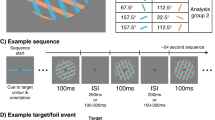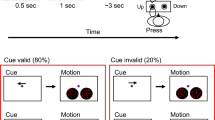Abstract
Event-related brain potentials (ERPs) were recorded from subjects who attended to pairs of adjacent colored squares that were flashed sequentially to produce a perception of movement. The task was to attend selectively to stimuli in one visual field and to detect slower moving _targets that contained the critical value of the attended feature, be it color or movement direction. Attention to location was reflected by a modulation of the early P1 and N1 components of the ERP, whereas selection of the relevant stimulus feature was associated with later selection negativity components. ERP indices of feature selection were elicited only by stimuli at the attended location and had distinctive scalp distributions for features mediated by “ventral” (color) and “dorsal” (motion) cortical areas. ERP indices of _target selection were also contingent on the prior selection of location but initially did not depend on the selection of the relevant feature. These ERP data reveal the timing of sequential, parallel, and contingent stages of visual processing and support early-selection theories of attention that stipulate attentional control over the initial processing of stimulus features.
Article PDF
Similar content being viewed by others
Avoid common mistakes on your manuscript.
References
Albright, T. D. (1984). Direction and orientation selectivity of neurons in visual area MT of the macaque.Journal of Neurophysiology,52, 1106–1130.
Allison, A. T., Begleiter, A., McCarthy, G., Roessler, E., Nobre, A. C., &Spencer, D. D. (1993). Electrophysiological studies of color processing in human visual cortex.Electroencephalography & Clinical Neurophysiology,88, 343–355.
Butler, S. R., Georgiu, G. A., Glass, A. A., Hancox, R. J., Hopper, J. M., &Smith, K. R. H. (1987). Cortical generators of the CI component of the pattern-onset visual evoked potential.Electroencephalography & Clinical Neurophysiology,68, 256–267.
Clark, V. P., Fan, S., &Hillyard, S. A. (1995). Identification of early visual evoked potential generators by retinotopic and topographic analyses.Human Brain Mapping,2, 170–187.
Clark, V. P., & Hillyard, S. A. (in press). Spatial selective attention affects early extrastriate but not striate components of the visual evoked potential.Journal of Cognitive Neuroscience.
Corbetta, M., Miezin, F. M., Dobmeyer, S., Shulman, G. L., &Petersen, S. E. (1991). Selective and divided attention during visual discriminations of shape, color, and speed: Functional anatomy by positron emission tomography.Journal of Neuroscience,11, 2383–2402.
Corbetta, M., Miezin, F. M., Shulman, G. L., &Petersen, S. E. (1993). A PET study of visuospatial attention.Journal of Neuroscience,13, 1202–1226.
DeYoe, E. A., Bandettini, P., Neitz, J., Miller, D., &Winans, P. (1994). Functional magnetic resonance imaging (FMRI) of the human brain.Journal of Neuroscience Methods,54, 171–187.
Duncan, J., &Humphreys, G. W. (1989). Visual search and stimulus similarity.Psychological Review,96, 433–458.
Duncan, J., &Humphreys, G. [W.] (1992). Beyond the search surface: Visual search and attentional engagement.Journal of Experimental Psychology: Human Perception & Performance,18, 578–588.
Eason, R. G., Harter, M. R., &White, C. T. (1969). Effects of attention and arousal on visually evoked cortical potentials and reaction time in man.Physiology & Behavior,4, 283–289.
Eriksen, C. W., &St. James, J. D. (1986). Visual attention within and around the field of focal attention: A zoom lens model.Perception & Psychophysics,40, 225–240.
Felleman, D. J., &Van Essen, D. C. (1987). Receptive field properties of neurons in area V3 of macaque monkey extrastriate cortex.Journal of Neurophysiology,57, 889–920.
Gomez Gonzalez, C. M., Clark, V. P., Fan, S., Luck, S. J., &Hillyard, S. A. (1994). Sources of attention-sensitive visual eventrelated potentials.Brain Topography,7, 41–51.
Hansen, J. C., &Hillyard, S. A. (1983). Selective attention to multidimensional auditory stimuli.Journal of Experimental Psychology: Human Perception & Performance,9, 1–19.
Harter, M. R., &Aine, C. J. (1984). Brain mechanisms of visual selective attention. In R. Parasuraman & D. R. Davis (Eds.),Varieties of attention (pp. 293–321). New York: Academic Press.
Harter, M. R., &Aine, C. J. (1986). Discussion of neural-specificity model of selective attention: A response to Hillyard and Mangun and to Näätänen.Biological Psychology,23, 297- 311.
Harter, M. R., Aine, C. [J.], &Schroeder, C. (1982). Hemispheric differences in the neural processing of stimulus location and type: Effects of selective attention on visual evoked potentials.Neuropsychologia,20, 421–438.
Harter, M. R., &Guido, W. (1980). Attention to pattern orientation: Negative cortical potentials, reaction time, and the selection process.Electroencephalography & Clinical Neurophysiology,49, 461–475.
Harter, M. R., &Previc, F. H. (1978). Size-specific information channels and selective attention: Visual evoked potential and behavioral measures.Electroencephalography & Clinical Neurophysiology,45, 628–640.
Haxby, J. V., Grady, C. L., Horwitz, B., Ungerleider, L. G., Mishkin, M., Carson, R. E., Herscovitch, P., Schapiro, M. B., &Rapoport, S. I. (1991). Dissociation of object and spatial visual processing pathways in human extrastriate cortex.Proceedings of the National Academy of Sciences of the United States of America,88, 1621–1625.
Heinze, H. J., Mangun, G.R., Burchert, W., Hinrichs, H., Scholz, M., Münte, T. F., Gos, A., Scherg, M., Johannes, S., Hundeshagen, H., Gazzaniga, M. S., &Hillyard, S. A. (1994). Combined spatial and temporal imaging of brain activity during visual selective attention in humans.Nature,372, 543–546.
Hillyard, S. A., Anllo-Vento, L., Clark, V. P., Heinze, H. J., Luck, S. J., & Mangun, G. R. (in press). Converging operations in the study of visual selective attention. In M. Coles, A. Kramer, & G. Logan (Eds.), Neuroimaging approaches to the study of visual attention: A tutorial. Washington, DC: American Psychological Association.
Hillyard, S. A., &Mangun, G. R. (1986). The neural basis of visual selective attention: A commentary on Harter and Aine.Biological Psychology,23, 265–279.
Hillyard, S. A., Mangun, G. R., Woldorff, M. G., &Luck, S. J. (1995). Neural systems mediating selective attention. In M. S. Gazzaniga (Ed.),The cognitive neurosciences (pp. 661–681). Cambridge, MA: MIT Press.
Hillyard, S. A., &Münte, T. F. (1984). Selective attention to color and location: An analysis with event-related brain potentials.Perception & Psychophysics,36, 185–198.
Jeffreys, D. A., &Axford, J. G. (1972). Source locations of patternspecific components of human visual evoked potentials: I. Components of striate cortical origin.Experimental Brain Research,16, 1–21.
Johnston, W. A., &Dark, V. J. (1982). In defense of intraperceptual theories of attention.Journal of Experimental Psychology: Human Perception & Performance,8, 407–421.
Kahneman, D., &Treisman, A. (1984). Changing views of attention and automaticity. In R. Parasuraman & D. R. Davies (Eds.),Varieties of attention (pp. 29–61). New York: Academic Press.
Kenemans, J. L., Kok, A., &Smulders, F. T. (1993). Event-related potentials to conjunctions of spatial frequency and orientation as a function of stimulus parameters and response requirements.Electroencephalography & Clinical Neurophysiology,88, 51–63.
LaBerge, D., &Brown, V. (1989). Theory of attentional operations in shape identification.Psychological Review,96, 101–124.
Luck, S. J., Hillyard, S. A., Mouloua, M., Woldorff, M. G., Clark, V. P., &Hawkins, H. L. (1994). Effects of spatial cuing on luminance detectability: Psychophysical and electrophysiological evidence for early selection.Journal of Experimental Psychology: Human Perception & Performance,20, 887–904.
Mangun, G. R., &Hillyard, S. A. (1990.) Allocation of visual attention to spatial locations: Tradeoff functions for event-related brain potentials and detection performance.Perception & Psychophysics,47, 532–550.
Mangun, G. R., Hillyard, S. A., &Luck, S. J. (1993). Electrocortical substrates of visual selective attention. In D. E. Meyer & S. Kornblum (Eds.),Attention and performance XIV: Synergies in experimental psychology, artificial intelligence, and cognitive neuroscience (pp. 219–243). Cambridge, MA: MIT Press.
McCarthy, G., &Wood, C. C. (1985). Scalp distributions of eventrelated potentials: An ambiguity associated with analysis of variance models.Electroencephalography & Clinical Neurophysiology,62, 203–208.
Merigan, W. H., &Maunsell, J. H. (1993). How parallel are the primate visual pathways?Annual Review of Neuroscience,16, 369–402.
Nakamura, H., Gattass, R., Desimone, R., &Ungerleider, L. G. (1993). The modular organization of projections from areas V1 and V2 to areas V4 and TEO in macaques.Journal of Neuroscience,13, 3681–3691.
Neville, H. J., &Lawson, D. (1987). Attention to central and peripheral visual space in a movement detection task: An event-related potential and behavioral study: I. Normal hearing adults.Brain Research,405, 253–267.
Plendl, H., Paulus, W., Roberts, I. G., Botzel, K., Towell, A., Pitman, J. R., Scherg, M., &Halliday, A. M. (1993). The time course and location of cerebral evoked activity associated with the processing of colour stimuli in man.Neuroscience Letters,150, 9–12.
Posner, M. I. (1980). Orienting of attention.Quarterly Journal of Experimental Psychology,32, 3–25.
Previc, F. H., &Harter, M. R. (1982). Electrophysiological and behavioral indicants of selective attention to multifeature gratings.Perception & Psychophysics,32, 465–472.
Probst, A. T., Plendl, H., Paulus, W., Wist, E. R., &Scherg, M. (1993). Identification of the visual motion area (area V5) in the human brain by dipole source analysis.Experimental Brain Research,93, 345–351.
Ritter, W., Simson, R., &Vaughan, H. G. (1983). Event-related potential correlates of two stages of information processing in physical and semantic discrimination trials.Psychophysiology,20, 168–179.
Sereno, M. I., Dale, A. M., Reppas, J. B., Kwong, K. K., Belliveau, J. W., Brady, T. J., Rosen, B. R., &Tootell, R. B. H. (1995, May 12). Borders of multiple visual areas in humans revealed by functional magnetic resonance imaging.Science,268, 889–893.
Tootell, R. B. H., Reppas, J. R., Kwong, K. K., Malach, R., Born, R. T., Brady, T. J., Rosen, B. R., &Belliveau, J. W. (1995). Functional analysis of human MT and related visual cortical areas using magnetic resonance imaging.Journal of Neuroscience,15, 3215–3230.
Treisman, A. [M.] (1993). The perception of features and objects. In A. D. Baddeley & L. Weiskrantz (Eds.),Attention: Selection, awareness, and control: A tribute to Donald Broadbent (pp. 5–35). Oxford: Oxford University Press, Clarendon Press.
Treisman, A. M., &Gelade, G. (1980). A feature-integration theory of attention.Cognitive Psychology,12, 97–136.
Treisman, A. [M.], &Gormican, S. (1988). Feature analysis in early vision: Evidence from search asymmetries.Psychological Review,95, 15–48.
Tsal, Y., &Lavie, N. (1988). Attending to color and shape: The special role of location in selective visual processing.Perception & Psychophysics,44, 15–21.
Tsal, Y., &Lavie, N. (1993). Location dominance in attending to color and shape.Journal of Experimental Psychology: Human Perception & Performance,19, 131–139.
Ungerleider, L. G., &Haxby, J. V. (1994). “What” and “where” in the human brain.Current Opinion in Neurobiology,4, 157–165.
Van der Heijden, A. H. C. (1992).Selective attention in vision. London: Routledge.
Van Voorhis, S., &Hillyard, S. A. (1977). Visual evoked potentials and selective attention to points in space.Perception & Psychophysics,22, 54–62.
Vasey, M. W., &Thayer, J. F. (1987). The continuing problem of false positives in repeated measures ANOVA in psychophysiology: A multivariate solution.Psychophysiology,24, 479–486.
Watson, J. D., Myers, R., Frackowiak, R. S., Hajnal, J. V., Woods, R. P., Mazziotta, J. C., Shipp, S., &Zeki, S. (1993). Area V5 of the human brain: evidence from a combined study using positron emission tomography and magnetic resonance imaging.Cerebral Cortex,3, 79–94.
Wijers, A. A., Lamain, W., Slopsema, J. S., Mulder, G., &Mulder, L. J. M. (1989). An electrophysiological investigation of the spatial distribution of attention to colored stimuli in focused and divided attention conditions.Biological Psychology,29, 213–245.
Wijers, A. A., Mulder, G., Okita, T., &Mulder, L. J. M. (1989). Event-related potentials during memory search and selective attention to letter size and conjunctions of letter size and color.Psychophysiology,26, 529–547.
Wilson, F. A., O’Scalaidhe, S. P., &Goldman-Rakic, P. S. (1993, June 25). Dissociation of object and spatial processing domains in primate prefrontal cortex.Science,260, 1955–1958.
Woldorff, M. G. (1993). Distortion of ERP averages due to overlap from temporally adjacent ERPs: Analysis and correction.Psychophysiology,30, 98–119.
Woods, D. L., &Alain, C. (1993). Feature processing during highrate auditory selective attention.Perception & Psychophysics,53, 391–402.
Woods, D. L., Alho, K., &Algazi, A. (1994). Stages of auditory feature conjunction: An event-related brain potential study.Journal of Experimental Psychology: Human Perception & Performance,20, 81–94.
Zeki, S., Watson, J. D., Lueck, C. J., Friston, K. J., Kennard, C., &Frackowiak, R. S. (1991). A direct demonstration of functional specialization in human visual cortex.Journal of Neuroscience,11, 641–649.
Author information
Authors and Affiliations
Corresponding author
Additional information
This study was supported by Grant MH-25594 from the National Institute of Mental Health and Grant NS-17778 from the National Institutes of Health, by Contract N00014-89-J-1806 from the Office of Naval Research, and by a postdoctoral fellowship from the San Diego McDonnell-Pew Center for Cognitive Neuroscience to the first author.
Rights and permissions
About this article
Cite this article
Anllo-Vento, L., Hillyard, S.A. Selective attention to the color and direction of moving stimuli: Electrophysiological correlates of hierarchical feature selection. Perception & Psychophysics 58, 191–206 (1996). https://doi.org/10.3758/BF03211875
Received:
Accepted:
Issue Date:
DOI: https://doi.org/10.3758/BF03211875




